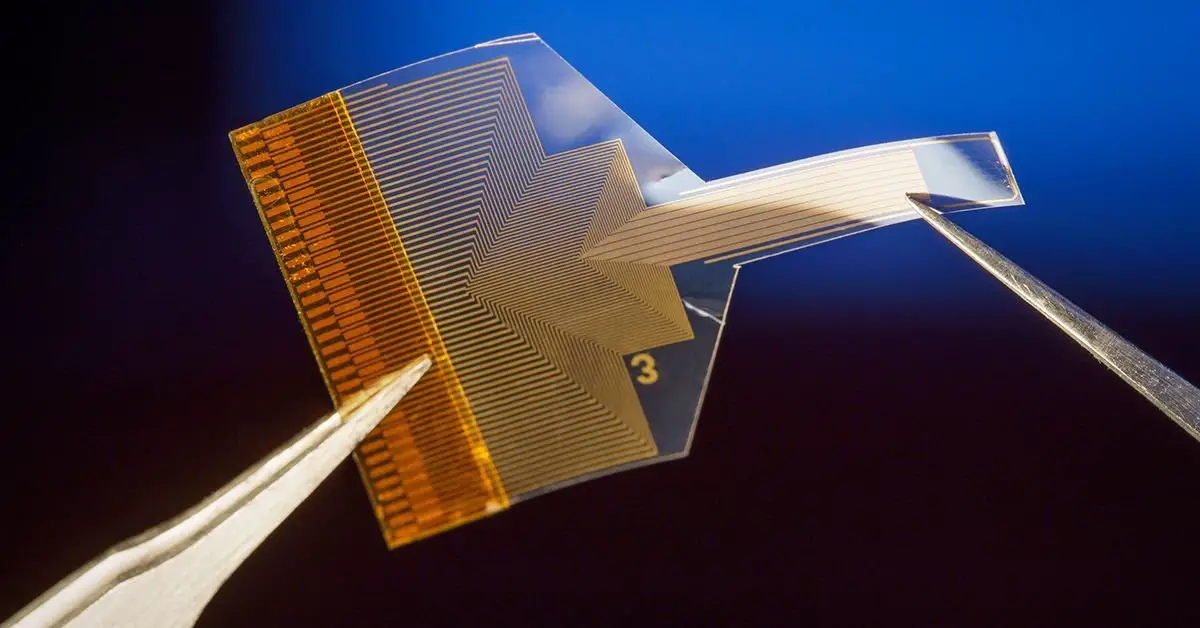Researchers at the University of California, San Diego (USA) have developed a brain or nerve implant that provides information about deep brain activity while remaining on its surface. This implant consists of a thin, transparent, flexible polymer strip, and is equipped with a dense network of graphene electrodes.
Tested in genetically modified mice, the technique brings researchers one step closer to creating a minimally invasive brain-computer interface (BCI) that provides high-resolution data on deep neuronal activity using recordings from the surface of the brain.
Innovative technology
A new neural implant was developed inUniversity of California, San Diego Offers the best of both worlds. The implant is a thin, transparent, flexible strip of polymer that conforms to the surface of the brain. The band is inlaid with a high-density mesh of Small circular graphene electrodesEach is 20 micrometers in diameter. Each electrode is connected by a graphene wire a few micrometers long to a printed circuit board.
When placed on the surface of the brain, the implant records electrical signals from neurons in the outer layers. Meanwhile, the researchers used a two-photon microscope to shine laser light through the implant to obtain images of calcium spikes in neurons up to 250 micrometers below the surface.
Promising results
The researchers found a relationship between surface electrical signals and high calcium in the deeper layers. This connection allowed the researchers to use surface electrical signals to train neural networks to predict calcium activity — not just for large groups of neurons, but also for individual neurons — at different depths.
The advantage of being able to predict calcium activity from electrical signals is that it overcomes the limitations of imaging experiments. When imaging calcium spikes, the person's head must be fixed under a microscope. These experiences may only last for an hour or two at a time.
Synthetic
For better understanding
What is a neural implant?
A neural implant is a medical device designed to stimulate, record, or block signals in the brain. These implants can be used to treat a variety of neurological disorders, such as Parkinson's disease, epilepsy, and depression.
What is a brain-computer interface?
Brain-computer interface (BCI) is a system that allows direct communication between the brain and an external device. Brain-interface interfaces (BCIs) are used in biomedical and neurological research, but also have potential applications in defense fields.
What is graphene?
Graphene is an allotrope form of carbon consisting of a single plane of carbon atoms arranged in a hexagonal lattice. It is extremely strong, lightweight, transparent and conductive, making it useful in a variety of applications, from electronics to medicine.
What is the activity of calcium in the brain?
Brain calcium activity refers to fluctuations in calcium concentrations in neurons, which plays a key role in how neurons communicate with each other. Calcium activity can be measured using special imaging techniques.
What are the advantages of this new technology?
This new technology provides high-resolution information about deep neuronal activity, which could improve our understanding of the brain and help develop new treatments for neurological disorders.
References
Illustration: This thin, flexible implant placed on the surface of the brain allows researchers to collect high-resolution information about the activity of neurons inside the brain without damaging its delicate tissue. Credit: David Pilot/UC San Diego Jacobs School of Engineering
Article “High-density transparent graphene arrays for predicting cellular calcium activity in depth from surface potential recordings” – DOI: 10.1038/s41565-023-01576-z
[ Rédaction ]

“Hardcore beer fanatic. Falls down a lot. Professional coffee fan. Music ninja.”







More Stories
Why does your cell phone get hot and what to do when it happens?
Canadian SMEs are moving from curiosity to action on AI
Secret earthquakes have been discovered in Montreal